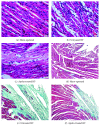Effects of Apelin on Left Ventricular-Arterial Coupling and Mechanical Efficiency in Rats with Ischemic Heart Failure
- PMID: 31316680
- PMCID: PMC6604493
- DOI: 10.1155/2019/4823156
Effects of Apelin on Left Ventricular-Arterial Coupling and Mechanical Efficiency in Rats with Ischemic Heart Failure
Abstract
Apelin plays important roles in cardiovascular homeostasis. However, its effects on the mechanoenergetics of heart failure (HF) are unavailable. We attempted to investigate the effects of apelin on the left ventricular-arterial coupling (VAC) and mechanical efficiency in rats with HF. HF was induced in rats by the ligation of the left coronary artery. The ischemic HF rats were treated with apelin or saline for 12 weeks. The sham-operated animals served as the control. The left ventricular (LV) afterload and the systolic and diastolic functions, as well as the mechanoenergetic indices were estimated from the pressure-volume loops. Myocardial fibrosis by Masson's trichrome staining, myocardial apoptosis by TUNEL, and collagen content in the aorta as well as media area in the aorta and the mesenteric arteries were determined. Our data indicated that HF rats manifested an increased arterial load (Ea), a declined systolic function (reduced ejection fraction, +dP/dtmax, end-systolic elastance, and stroke work), an abnormal diastolic function (elevated end-diastolic pressure, τ, and declined -dP/dtmax), and decreased mechanical efficiency. Apelin treatment improved those indices. Concomitantly, increased fibrosis in the LV myocardium and the aorta and enhanced apoptosis in the LV were partially restored by apelin treatment. A declined wall-to-lumen ratio in the mesenteric arteries of the untreated HF rats was further reduced in the apelin-treated group. We concluded that the rats with ischemic HF were characterized by deteriorated LV mechanoenergetics. Apelin improved mechanical efficiency, at least in part, due to the inhibiting cardiac fibrosis and apoptosis in the LV myocardium, reducing collagen deposition in the aorta and dilating the resistant artery.
Figures




Similar articles
-
Early Administration of Apelin Could Prevent Heart Failure Following Myocardial Injury; A Systematic Review and Meta-Analysis.Arch Acad Emerg Med. 2024 Sep 5;13(1):e4. doi: 10.22037/aaem.v13i1.2414. eCollection 2025. Arch Acad Emerg Med. 2024. PMID: 40093029 Free PMC article. Review.
-
[Sacubitril/valsartan attenuates left ventricular remodeling and improve cardiac function by upregulating apelin/APJ pathway in rats with heart failure].Zhonghua Xin Xue Guan Bing Za Zhi. 2022 Jul 24;50(7):690-697. doi: 10.3760/cma.j.cn112148-20211008-00862. Zhonghua Xin Xue Guan Bing Za Zhi. 2022. PMID: 35856226 Chinese.
-
Tanshinone IIA attenuates heart failure via inhibiting oxidative stress in myocardial infarction rats.Mol Med Rep. 2021 Jun;23(6):404. doi: 10.3892/mmr.2021.12043. Epub 2021 Mar 31. Mol Med Rep. 2021. PMID: 33786621 Free PMC article.
-
Comparison of the effects of levosimendan, pimobendan, and milrinone on canine left ventricular-arterial coupling and mechanical efficiency.Basic Res Cardiol. 1996 Jul-Aug;91(4):296-307. doi: 10.1007/BF00789302. Basic Res Cardiol. 1996. PMID: 8874779
-
Clinical aspects of left ventricular diastolic function assessed by Doppler echocardiography following acute myocardial infarction.Dan Med Bull. 2001 Nov;48(4):199-210. Dan Med Bull. 2001. PMID: 11767125 Review.
Cited by
-
The Apelin/APJ System: A Potential Therapeutic Target for Sepsis.J Inflamm Res. 2024 Jan 17;17:313-330. doi: 10.2147/JIR.S436169. eCollection 2024. J Inflamm Res. 2024. PMID: 38250143 Free PMC article. Review.
-
Adipokines, Myokines, and Cardiokines: The Role of Nutritional Interventions.Int J Mol Sci. 2020 Nov 8;21(21):8372. doi: 10.3390/ijms21218372. Int J Mol Sci. 2020. PMID: 33171610 Free PMC article. Review.
-
Induced dysregulation of ACE2 by SARS-CoV-2 plays a key role in COVID-19 severity.Biomed Pharmacother. 2021 May;137:111363. doi: 10.1016/j.biopha.2021.111363. Epub 2021 Feb 5. Biomed Pharmacother. 2021. PMID: 33582450 Free PMC article. Review.
-
The Apelinergic System: Apelin, ELABELA, and APJ Action on Cell Apoptosis: Anti-Apoptotic or Pro-Apoptotic Effect?Cells. 2022 Dec 30;12(1):150. doi: 10.3390/cells12010150. Cells. 2022. PMID: 36611944 Free PMC article. Review.
-
Early Administration of Apelin Could Prevent Heart Failure Following Myocardial Injury; A Systematic Review and Meta-Analysis.Arch Acad Emerg Med. 2024 Sep 5;13(1):e4. doi: 10.22037/aaem.v13i1.2414. eCollection 2025. Arch Acad Emerg Med. 2024. PMID: 40093029 Free PMC article. Review.
References
-
- Yang P., Read C., Kuc R. E., et al. Elabela/toddler is an endogenous agonist of the apelin APJ receptor in the adult cardiovascular system, and exogenous administration of the peptide compensates for the downregulation of its expression in pulmonary arterial hypertension. Circulation. 2017;135(12):1160–1173. doi: 10.1161/CIRCULATIONAHA.116.023218. - DOI - PMC - PubMed
MeSH terms
Substances
LinkOut - more resources
Full Text Sources
Medical
Research Materials
Miscellaneous

